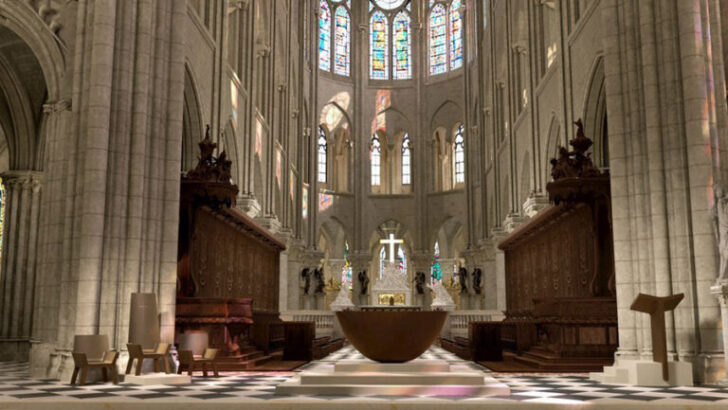The reopening of Notre Dame, which took place finally on December 8, is one of the great ecclesiastical events of the year, saved for the final days of 2024, giving the world something real to celebrate.
The restoration of the cathedral, as previous articles in these pages have noted, has been a task fraught with a great deal of debate and controversy. Much of this was of the moment. For President Macron and for the Church in France the reopening has been a special moment of glory.
For Macron it is at last an achievement by his contested regime which all will applaud, for the actual fabric is the property of the French state. For the Catholic Church, who have the use of it, it too has been a moment of achievement as well, one where the attention of the public is focused for a one joyful moment on an ecclesiastical edifice.
Manipulation
But what does the building actually mean today? It has become an object of political and social manipulation in which its ‘real meaning’ is lost.
This book by the great German-born art historian and philosopher, much of whose career was inevitably, after the rise of the National Socialist German Workers Party, passed in the United States of America, then a country which valued both academic and religious freedom, values which now seem under attack from various directions. He died in 1969.
This book was first published in 1951. It represents his response to an invitation to present the ‘Wimmer Lectures’, established in memory of the founder of the Benedictine Order in the US, Boniface Wimmer. The lectures are usually given under the auspices of Saint Vincent Archabbey, near Pittsburgh. This book has been in print ever since.
Quentin L. Schaut OSB, his foreword to the book, discusses what Wimmer saw as the duty of the Benedictines to promote religious art, and beyond that an understanding of religious art.
In his lectures Panofsky’s theme was “the profound co-relation between the development of Gothic architecture and the growth of scholastic philosophy. Panofsky demonstrated architectural style and structures “provided visible and tangible equivalents to the scholastic definitions of order and the form of thought’.
Scholasticism, which had its roots, of course, in Greek philosophy, was a necessary development of the Middle Ages.
Transformed
The Church’s life and experience has been transformed since then. It has had to find new ways of responding to what we actually know about the world and about man today, knowledge that far exceeds what was available to the medieval monastic tradition.
Panofsky explained about the inner meaning of Gothic architecture in clear and forthright language. He opens up to his readers the meaning of what can be seen in the very stones, decorations and painted glass of a cathedral such as Notre Dame (and its counterparts across Europe).
Those readers wanting a more straightforward exposition of the history of Gothic architecture will find it in When the Cathedrals were Painted, by Alain Erlande-Brandburg (Thames & Hudson, €11.15), which underlines the fact that the pale grey and cream stone work and carvings we see today were once a polychromatic delight to the eye, and appeared gloriously different to what they are now.
But the meaning of Notre Dame today cannot be quite as it was in the Middle Ages. Far from being a work of one moment or a statement of faith at a particular time merely, the renovated Notre Dame demands an intellectual response from Christians seeking to invigorate their faith today.
In this task they cannot afford to ignore any contribution. Erwin Panofsky was a German Jew who fled the advent of an intolerant regime set on destruction as an end itself. He, by contrast, celebrated manual and mental construction, recreation in all its meanings.
There are lessons to be learned by all of us in these pages first issued to the world under the auspices of the rule of St Benedict. We need to keep in mind that the re-opening of Notre Dame is not an end itself, but merely a new start towards a truer understanding of humanity’s spiritual dimensions.


 Peter Costello
Peter Costello The liturgical furniture designed by designer and sculptor Guillaume Bardet, seen in an undated photo, is composed of five elements in the restored Notre Dame Cathedral in Paris: the altar, the cathedra and the associated seats, the ambo, the tabernacle and the baptistery. Each of the pieces was designed in sculpted bronze, a material offering a powerful, timeless and luminous aesthetic. (OSV News photo/courtesy Archdiocese of Paris, Guillaume Bardet)
The liturgical furniture designed by designer and sculptor Guillaume Bardet, seen in an undated photo, is composed of five elements in the restored Notre Dame Cathedral in Paris: the altar, the cathedra and the associated seats, the ambo, the tabernacle and the baptistery. Each of the pieces was designed in sculpted bronze, a material offering a powerful, timeless and luminous aesthetic. (OSV News photo/courtesy Archdiocese of Paris, Guillaume Bardet) 